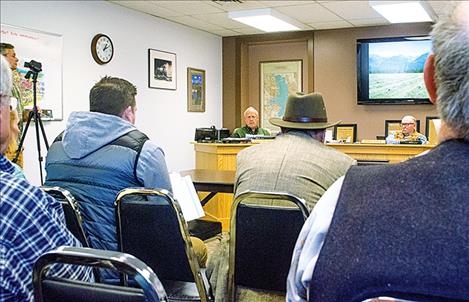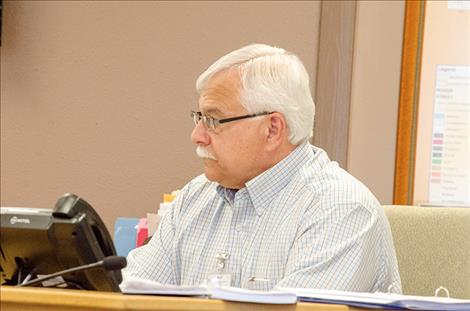Density regulations become advisory in Lake County
Hey savvy news reader! Thanks for choosing local.
You are now reading
1 of 3 free articles.
POLSON – A document regulating development in rural Lake County for more than a dozen years will now be considered advisory with the rules no longer set in stone. “This won’t be as good as some think or as bad as others believe it will be,” Commissioner Dave Stipe said. Lake County Commissioners voted 3-0 to repeal the Lake County Density Map and Regulations on Tuesday, April 24, during the final reading. Commissioner Gale Decker said public comment would not be taken before the vote due to the many hours of comments and letters already reviewed. During the short meeting, he read Resolution 18-15 to repeal the DMRs. The resolution states the Density Map and Regulations were intended to implement the goals and objectives of the 2003 Growth Policy, not the goals and objectives of the 2018 Growth Policy rewrite that is currently in the revision process. “The County Commissioners have determined that the adopted Density Map and Regulations did not assist the County in meeting many of the goals and objectives of the 2003 Policy,” Decker said while reading. The document goes on to state that county zoning was supposed to encourage and facilitate provisions for housing opportunities near existing capital improvements, but that hasn’t happened because opportunities to build homes near existing sewer and water systems generally do not exist due to lack of capacity. The document also mentions the numerous comments supporting the DMRs from the public that state the zoning has “saved the character of Lake County since adoption,” but the resolution argues that there hasn’t been an explanation of how the regulations accomplished that task. Other comments have expressed a desire to repeal the DMRs stating that they are an “over-reach by the government taking land value and rights from owners,” according to the document. The county commissioners, as stated, also have a desire for all landowners in the county to be treated equally by land use regulations without differing regulations for tribal and non-tribal members. After the meeting, Commissioner Stipe said it has taken about two years to get to the final vote to repeal the DMRs. He said the next step is to adopt the 2018 general plan with the DMRs as an advisory document. Stipe said there will not be a “free for all” on development in the county even though the regulations are now advisory. People will still need to go through the Lake County Planning Board to get approval, he explained, and the DMRS will be considered. “This doesn’t mean the Oklahoma Land Rush will start,” he said. He added that people should look north of Polson at the lots that are not selling to see that subdivision development isn’t profitable. He noted that when people build subdivisions it changes their tax structure and costs them more. He believes the regulations haven’t kept up with the way people want to live. He said more families want to develop homes on parcels of land so that they can be close but not live together. He also said people want to subdivide land to sell an existing home next to their home but the regulations don’t allow it. Stipe said he received a letter from a woman in St. Ignatius who would like to subdivide her 10 acres into two lots, but the regulations haven’t allowed her to do that in the past. She wrote that her husband’s parents built a home on their property after hurricane destruction in Florida brought them to the area. “We gifted three acres to them at the time,” the woman says. Two years later, the woman’s mother-in-law was killed in a car crash. Her father-in-law later passed away, and the new house was left empty. She wanted to sell it to get out from under a tax burden but couldn’t. Stipe said he thought about problems like this when he made his decision. The Lake County Planning Board, an advisory board to the commissioners, voted on April 11 to recommend that the commissioners keep the density map and regulations as regulatory. Stipe said he appreciates the diverse opinions on the advisory board, but had to consider other issues when he voted. He said legal issues were the biggest factor in his decision. He explained that the county originally passed the regulations in 2005 using documents they are not able to produce as evidence concerning legal problems, although they haven’t been sued. The resolution to repeal the DMRs reiterates Stipe’s sentiment. It states the Density Map is based on information not available to the public or Lake County and therefore findings to support the map and initial adoption are not adequate or defendable. Commissioner Bill Barron offered a solution after the meeting for people who don’t want to see development happen around their homes. He said people can form a homeowner’s district and get those areas zoned. “They can set those up the way they want it,” he said. For example, people might decide only one house can be built for every five acres in their zoned area. He added that the process involves some paperwork and the consensus of the homeowners. The Confederated Salish and Kootenai Tribes have supported keeping the DMRs as regulatory to protect homes, the environment, wildlife habitat, clean water, open spaces and farmland. Janet Camel, Lake County Planning Board member and CSKT planner, shared a letter dated April 24 from CSKT Chairman Ronald Trahan to the County Commissioners. Trahan’s letter addresses the section in the commissioner’s resolution to repeal the DMRs pertaining to their desire that all landowners in Lake County be treated equally by land use regulations because the DMRs don’t apply to tribal trust land. Trahan states that a Memorandum of Understanding could be used to resolve differences in the two jurisdictions. “Effective communication will likely solve many issues,” he states. The letter continues to say: “The Tribes stand ready to uphold the DMRs if they remain regulatory. Should the DMRs remain regulatory, the Tribes welcome the opportunity to review development projects of concern with the Commissioners and staff and talk about a potential (Memorandum of Understanding) or other agreement that would help eliminate misunderstandings and find solutions.” Trahan notes that the Tribes continue to see the DMRs as a highly effective way for the governments to work together on shared planning. “(We) are committed to developing a cooperative agreement to ensure fair application of the DMRs to those subject to the jurisdiction of our governments.”

















